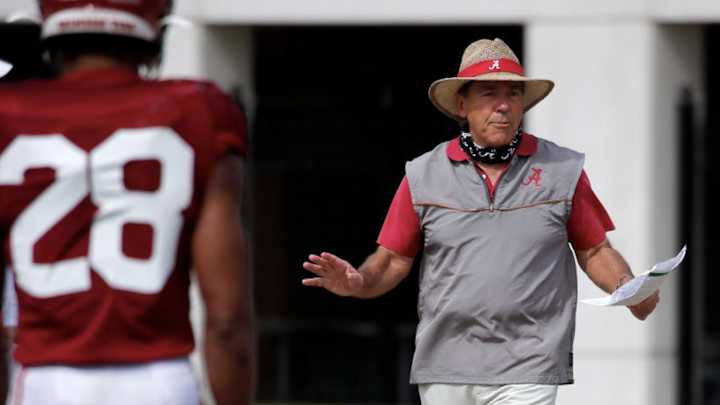A-Day Game a Big Event Since Nick Saban's Arrival at Alabama

Alabama football changed forever on Jan. 3, 2007 when Nick Saban stepped off an airplane in Tuscaloosa as the Crimson Tide’s 27th coach.
We all know what Alabama’s gotten over the decade since – the national titles, the top-ranked recruiting classes, the hoard of first-round NFL Draft picks and all the hate and scorn of every other fan base across the country.
No one could have predicted all that back in January of 2007, but a couple of months later we did get a preview that something special was happening, and Crimson Tide fans were ready for it.
On April 21, 2007, more than 92,000 fans packed inside Bryant-Denny Stadium for the annual A-Day Game. That number could have easily been 95,000-plus but fans were turned away because the stadium was at full capacity.
For a spring game.
It was a wild scene indeed to see throngs of fans continue to enter the stadium as kickoff time approached, just to watch a scrimmage.
“It shows what great passion and support we have at the University of Alabama, and it certainly made me feel great about being here as the coach,” Saban said after the game. “I hope we can continue to channel all that energy in a positive way, so we can get where we want to go, so we can build this program into something special.”
On this date in 2007, Alabama had to close the gates at Bryant-Denny Stadium after capacity had been exceeded for Nick Saban's first A-Day. Crimson Tide Roll Call: https://t.co/M4X4wLtiFO pic.twitter.com/3cKeCWKng7
— BamaCentral (@BamaCentral) April 21, 2020
There will not be 92,000-plus fans in attendance for Saturday’s A-Day Game. The Crimson Tide and Saban would surely love nothing more than to have a capacity crowd, but COVID-19 restrictions have limited attendance to 50%.
Fans will also have to pay. The game is normally free, but tickets will be sold for $5.
That 2007 Alabama A-Day Game was the talk of the spring and made waves all across the country. For football-hungry fans, any morsel of football tidbits is welcomed in the offseason, and big news like record-setting attendance for a spring game took center stage.
The 2007 spring game changed everything, and not just at Alabama. While the Crimson Tide continued to have above 60,000-plus for each A-Day game afterward, other schools saw an increase as well.
Nebraska’s spring game attendance shot to around 80,000 in 2008, which had mostly to do with the hiring of Bo Pelini as head coach. The previous year, the Huskers were behind Alabama in attendance with just over 54,000, which was around the average before 2008. Nebraska’s numbers jumped into the 60- to 70,000-range afterward.
Ohio State saw a major bump with attendance two years later in 2009 with 95,722 fans. The Buckeyes topped that in 2016 with 101,189, the most fans for any spring game.
Since 2007 spring game attendance has increased dramatically for most of the Power 5 schools like Ohio State, Penn State and Georgia. Auburn even got in on the action after the Gus Malzahn hiring as 83,401 showed up for the 2013 spring game.
There isn’t much data on spring game attendance prior to 2008, but since the record-setting 2007 game at Alabama, attendance records for spring games became important.
Of course, a big reason for that has to do with recruiting. Alabama was the talk of the spring in 2007, which was basically free advertising. And very positive advertising at that.
Big-time recruits are usually on the sidelines during the spring game, and what better way to showcase your program’s relevance than by having a game-day atmosphere for a simple scrimmage?
So, a simple scrimmage turned into a major production. Other schools put together public relations campaigns and got the word out to fans to show up in big numbers. And it worked. ESPN took notice of Alabama’s attraction as well and has become a regular fixture for A-Day since.
A-Day has become important for the city of Tuscaloosa, too. Having that many people in town is almost like an extra home game, which brings in several thousand dollars. Before Saban arrived, the most fans at an A-Day Game was around 51,000 in 1988. Since then, the numbers averaged around 30,000 before the big boom of 2007.
There won’t as much of an economic impact as a normal A-Day this year due to attendance restrictions. Charging $5 will help Alabama, though. One can only imagine if Alabama had sold tickets for A-Day back in 2007.

Edwin Stanton has been a sports writer for more than 20 years, and has covered University of Alabama sports for 10 years.
Follow edwinstantonu2